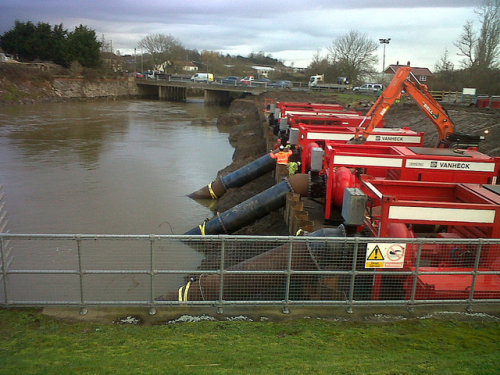
Last Christmas the UK was once again victim of severe flood, with the South West of the country being particularly badly affected. As a result it was decided to have pumps shipped in from the Netherlands, early February in order to help with the clean-up operations, and stay in place until the end of March, or until early April in some places where flood waters were still quite high.
The operation to bring the pumps over was led by the UK police working together with the Environment Agency and the other emergency services. Some 30 lorries were required to deliver the pumps and the units are so large that getting them on site required the closure some local roads including a local A road.
The pumps, distributed by Prestige Pumps, were put in place in the local towns of Huntworth, Dunball and Beer and were part of what was dubbed at the time as the “biggest pumping operation ever”. They were able to shift 7.3 million tonnes of water per day (enough to fill Wembley stadium seven times).
Pump controversy
Earlier during the pumping operation there was some controversy when four of the pumps that had been installed along the river at Dunball had to be switched off following damage to the river bank. Engineers then worked round the clock to fit pipe extensions that would limit damage to the river bank.The pumps also caused controversy when UK MPs were told that the fuel to run them would cost £1 million per month. However, the UK’s Association of Drainage Authorities justified the cost by stating that the dredging had to take place quickly in order to avoid more severe damage during potential summer flooding similar to that of 2012.
After some time, according to the Environment Agency, the pumps were “hugely effective” in lowering water levels, and were therefore no longer needed in areas where flood water had receded sufficiently. It was therefore decided that the four pumps installed in Huntworth will be dismantled and sent back to the Netherlands, while a further eight pumps remained in place at Dunball and Beer dues to major concerns of further flooding in that area of Somerset.
The future
Because there are no hills high enough to naturally drain floodwater, the Somerset level are for most part below sea level. Therefore, following this major crisis, Somerset residents together with the Environment Agency have begun to look at other ways to cope with flooding in the future. Some of the plans include planting trees in order to break down the flow of the river and protect buildings and other infrastructure that is located close to the riverbank. Other solutions include raising the level on which houses and roads are built in order to protect them from flooding.
Finally there is the possibility of building a tidal lagoon which would keep the tide out when needed, creating a huge storage wall for any excess water. The lagoon would be installed in a 16 km long wall around the Bridgwater Bay in North Somerset. The lagoon is also viable solution due to the fact that it can generate up to 3.6 GW of electricity by using the current generated by the waves which means it would pay for itself.
However, pumping remains a viable solution as high volumes of water can be diverted from the flooded areas very quickly and efficiently by using heavy duty pumps. Regardless of which solution is chosen to protect the Somerset levels, the government has pledged to invest £13 million in flood defences for this area. Pumps will, of course, remain on standby if dredging is required as it is the quickest way to divert and drain flood water during a clean-up operation.




